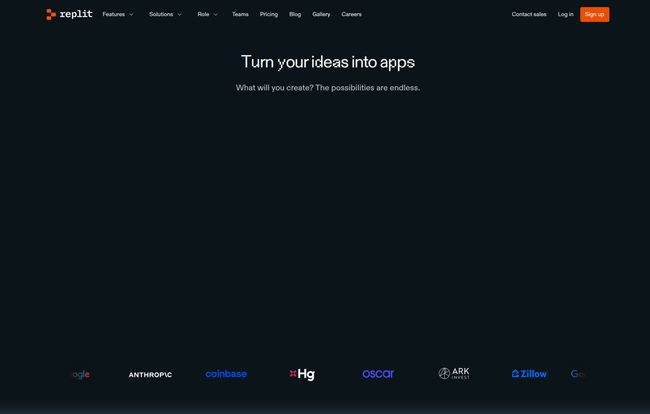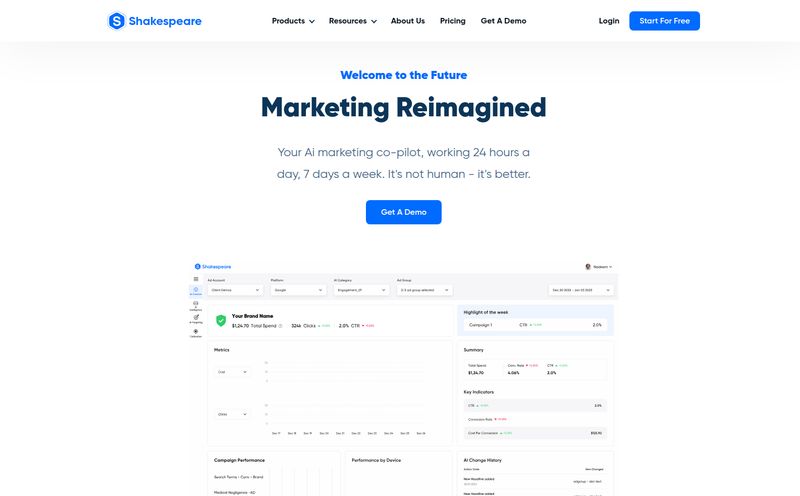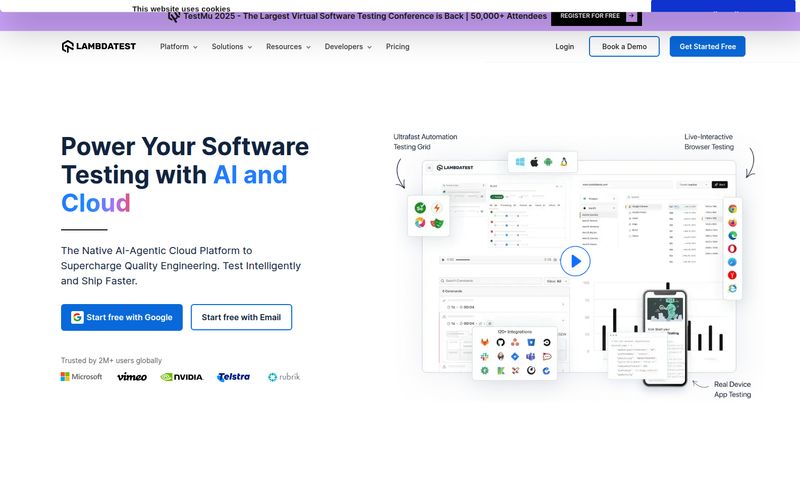I’ve lost count of the hours—no, days—I’ve spent wrestling with local development environments. You know the drill. That sinking feeling when you clone a new repo and the `npm install` command unleashes a torrent of cryptic errors. Or the classic, “Well, it works on my machine!” defense. It’s a rite of passage for developers, but honestly, I’m over it.
For a while now, I've been keeping a close eye on cloud-based IDEs, and one name keeps popping up everywhere: Replit. It promises a world with no setup, seamless collaboration, and even an AI coding partner. But as a seasoned pro in the traffic and trends game, I’m naturally skeptical of anything that sounds too good to be true. So, I took it for a proper spin. And, well... I have some thoughts.

Visit Replit
So, What Exactly Is Replit?
Calling Replit just an “online code editor” is like calling a smartphone just a “pocket calculator.” It’s technically true, but misses the entire point. Replit is a complete development ecosystem that lives entirely in your browser. Think of it as a coding environment, a compiler, a deployment platform, and a collaborative workspace all rolled into one slick package.
You can write and run code in over 50 languages—from Python and JavaScript to more niche stuff—without installing a single thing. It’s this instant-on, zero-friction approach that first caught my attention. The idea of going from a fresh idea to a running app in minutes isn't just a marketing line; it's startlingly close to the truth here.
My Favorite Replit Features (The Ones That Actually Matter)
Every platform boasts a long list of features, but which ones will you actually use? After kicking the tires, here’s what stood out to me.
The Zero-Setup Dream
This is the big one. The absolute magic of Replit is opening a new tab and just… starting to code. There's no wrestling with PATH variables, no library conflicts, no `virtualenv` headaches. You just pick your language or template, and you’re in. This alone is a massive productivity boost, especially for quick prototypes, tutorials, or small-to-medium-sized projects. It democratizes coding in a way that’s hard to overstate. It’s like being handed a fully stocked kitchen instead of having to build the oven yourself before you can bake a cake.
Your AI Coding Partner: Replit Agent
Okay, let’s talk about the AI. Replit's integrated AI, which they call the Replit Agent, is more than just fancy autocomplete. It’s a genuinely useful assistant. On their paid plans, you get access to powerful models like OpenAI's GPT-4o and Anthropic's Claude Sonnet 3.7. It can help you debug code, explain complex snippets, generate boilerplate, and even help architect entire sections of your app. I asked it to refactor a clunky Python script I wrote, and the suggestions were not just syntactically correct but idiomatically better. It's not going to replace your brain, but it’s an incredible sparring partner that helps you get past those moments when you're just staring at a blank screen.
Collaboration That Doesn't Suck
Remember trying to code with a teammate over a laggy screen share? It's painful. Replit introduces multiplayer mode, which is essentially Google Docs for your codebase. You and your team can jump into the same file and code in real-time. You see each other's cursors, you can chat, and you can run the code instantly to see the changes. For pair programming, team projects, or even educational settings, this is an absolute game-changer. No more passing zip files back and forth like it's 2005.
Who Is Replit For? (And Who Should Maybe Skip It?)
I see Replit shining for a few key groups:
- Beginners & Students: The zero-setup environment is a godsend for anyone just starting their coding journey. It removes a huge barrier to entry.
- Hobbyists & Prototypers: If you have an idea and want to build a quick proof-of-concept without the setup ceremony, Replit is your best friend.
- Freelancers & Small Teams: The collaboration and easy deployment features can seriously streamline workflows for smaller, agile teams that need to move fast.
However, if you're a developer working on a massive, high-performance enterprise application that requires complex, custom local build configurations or you need to work offline frequently, you might find it a bit confining. It's a fantastic tool, but it's not meant to replace every single local setup for every single use case. And that’s okay.
Let's Talk Money: Breaking Down Replit's Pricing
Alright, the all-important question: what’s this going to cost? Replit uses a freemium model, which I appreciate. You can do a surprising amount without ever pulling out your wallet.
Here’s a quick, no-fluff breakdown as I see it:
The Starter Plan is completely Free. This is perfect for exploring the platform. You get access to the basic IDE and can build public projects. The catch is that your apps have temporary links and you only get a trial of the full Replit Agent. It's a generous free tier for learning and tinkering.
Next up is Replit Core, which will set you back $20 per month (if billed annually). For my money, this is the sweet spot for most serious individual users. This unlocks the full power of the AI Agent, gives you unlimited private projects, and lets you deploy and host live apps with permanent URLs. It also includes $25 in monthly credits for compute resources, which is pretty neat.
For businesses, there's the Teams Plan at $35 per user/month. This includes everything in Core plus centralized billing, role-based access controls, and more collaboration features. A solid choice for professional development teams who want to adopt a cloud-based workflow.
Finally, there’s a custom Enterprise Plan for large organizations that need features like SSO, advanced security controls, and dedicated support. You'll have to talk to their sales team for that one.
"The rapid prototypes we build on Replit lead to dialogues: ‘Should we?’ to ‘How should we?’ And that’s a critical distinction when driving substantive change." – SHAWN WANG, FOUNDER OF SMOL.AI
The Not-So-Great Stuff (Let's Be Honest)
No tool is perfect, right? My main gripe, and it's an obvious one, is the reliance on an internet connection. On a flight or in a coffee shop with spotty Wi-Fi? You're out of luck. This is the fundamental trade-off for a cloud-based tool.
Secondly, while the performance is generally impressive, for very computationally intensive tasks, you might still feel the slight lag compared to a beastly local machine. And of course, the cost can be a factor. While the free tier is great, to really unlock Replit's full potential with the best AI and private deployments, you have to move to a paid plan.
My Final Verdict on Replit
So, am I ditching my local setup entirely? Not quite. But Replit has earned a permanent spot in my digital toolbox. It's not an all-or-nothing proposition. I find myself using it constantly for new ideas, for collaborating with other marketers on simple scripts, and for teaching my nephew the basics of Python without the setup drama.
Replit feels like the future of development—more accessible, more collaborative, and smarter. It lowers the floor for beginners while raising the ceiling for what a single developer or a small team can accomplish quickly. If you haven't given it a try, especially with its robust free tier, you're genuinely missing out. It might just change the way you code.
Frequently Asked Questions About Replit
- Can I use Replit for free?
- Yes, absolutely. The free Starter plan is quite generous and perfect for learning, building public projects, and getting a feel for the platform. You can code, run projects, and use the basic editor without paying a cent.
- What programming languages does Replit support?
- Replit supports over 50 languages right out of the box, including popular ones like Python, JavaScript (Node.js), HTML/CSS, Java, C++, and many more. There's a high chance that whatever you want to work with, Replit has you covered.
- Is Replit good for professional developers?
- Yes, it can be. While some may prefer a local setup for large-scale projects, Replit's Teams and Core plans are designed for professionals. The AI assistance, one-click deployments, and real-time collaboration can significantly speed up development cycles, especially for web apps and APIs.
- How does Replit's AI coding assistant work?
- The Replit Agent uses advanced large language models (like GPT-4o and Claude) to provide contextual help. It can autocomplete code, suggest entire functions, explain code you don't understand, find bugs, and help you build out your application. It's like having a senior developer pair-programming with you.
- Can I host a real website on Replit?
- Yes! With the paid Replit Core plan, you can deploy and host live web applications with a permanent URL. The free plan allows for hosting but with temporary links. It's a very straightforward way to get your project on the internet.
- Is my code private on Replit?
- On the free plan, all your projects (they call them Repls) are public. To create private Repls that are only visible to you and your collaborators, you will need to upgrade to a paid plan like Replit Core.



